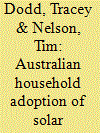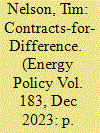| Srl | Item |
| 1 |
ID:
125729


|
|
|
|
|
| Publication |
2013.
|
| Summary/Abstract |
In 2001, Australia introduced legislation requiring investment in new renewable electricity generating capacity. The legislation was significantly expanded in 2009 to give effect to a 20% Renewable Energy Target (RET). Importantly, the policy was introduced with bipartisan support and is consistent with global policy trends. In this article, we examine the history of the policy and establish that the 'stop/start' nature of renewable policy development has resulted in investors withholding new capital until greater certainty is provided. We utilise the methodology from Simshauser and Nelson (2012) to examine whether capital market efficiency losses would occur under certain policy scenarios. The results show that electricity costs would increase by between $51 million and $119 million if the large-scale RET is abandoned even after accounting for avoided renewable costs. Our conclusions are clear: we find that policymakers should be guided by a high level public policy principle in relation to large-scale renewable energy policy: constant review is not reform.
|
|
|
|
|
|
|
|
|
|
|
|
|
|
|
|
| 2 |
ID:
183036


|
|
|
|
|
| Summary/Abstract |
Prior studies establish that electricity systems across the globe need to transition toward renewable energy and that renters have a low adoption of effective means to do so through access to household solar photovoltaics (PV). Yet, the economic, environmental, and social costs of low PV adoption by people who have trouble paying their electricity bills (hardship customers), who are more likely to be low-income tenants, remain understudied. Drawing on electricity use data from an Australian energy retailer we compare the performance of PV for hardship customers against ‘average’ households. Results illustrate that if society could achieve greater solar PV installation on hardship homes, annual grid-based electricity consumption could be reduced by 40%, lowering greenhouse gas emissions by 1.6 tCO2e per household annually and energy bills by $2908 per low-income household over 15 years. We illustrate how Australian policy could be re-oriented to encourage greater PV adoption on hardship properties, including through support for a new market structure that distributes the economic benefits of PV between renters and landlords.
|
|
|
|
|
|
|
|
|
|
|
|
|
|
|
|
| 3 |
ID:
192826


|
|
|
|
|
| Summary/Abstract |
This research advances knowledge regarding social equity as it relates to electricity network charges, renewable investments, and household income. While much research has examined social equity issues related to electricity access, research has yet to fully explore how different network tariff designs used to recover the cost of renewable energy investments, such as those related to ‘Contracts-for-Difference’ (CfDs), impact low-income individuals. We accordingly examine CfDs in more detail, assessing if regressive effects emerge from levying CfD cost recovery via network charges. By analysing energy use and network design charges in Australia, we find that CfDs are a regressive form of taxation used by state governments to fund renewable energy commitments. We illustrate the impact that CfDs have on different energy users and provide recommendations to reform renewable energy policies to provide greater social equity.
|
|
|
|
|
|
|
|
|
|
|
|
|
|
|
|
| 4 |
ID:
162904


|
|
|
|
|
| Summary/Abstract |
Saunders and Bedford (2017) demonstrated that income levels are inadequate for some Australian households to maintain a basic standard of living. Analysing utility bills can extend this consideration of income adequacy issues given the essential nature of services such as electricity, telephony and water. This article builds on the work presented by Simshauser and Nelson (2014) about key demographic cohorts in Australia that have a high incidence of energy-related financial hardship. Our analysis indicates that energy related financial hardship is likely to be related to a combination of the following: family formation demographics; low-income (often reliant upon government income support); higher household size; and higher than average consumption. Our policy recommendations are relatively straightforward: development of tools to allow easier ‘shopping around’ by energy customers; cessation of credit-checking by energy retailers as a means of restricting access to energy offers; reform of state-based concessions frameworks; a lifting of income support for some key cohorts (e.g. unemployed); improvements to energy-efficiency standards; and amendments to tenancy laws to overcome potential principal-agent issues associated with uptake of new energy products and services such as embedded solar PV and battery storage.
|
|
|
|
|
|
|
|
|
|
|
|
|
|
|
|
| 5 |
ID:
115648


|
|
|
|
|
| Publication |
2012.
|
| Summary/Abstract |
With the ongoing development of Australian anthropogenic climate change mitigation policies, there has been a steady increase in modelling studies undertaken to estimate Australian carbon prices and their impact on existing electricity markets. This article summarises some of the more prominent studies completed by many of Australia's foremost economic modelling firms. We developed a simple approach for testing the consistency of these studies and their findings in relation to carbon pass-through. Unfortunately, we have established that the studies are entirely inconsistent in their estimation of carbon pass-through. Furthermore, we were unable to establish why the estimation of carbon pass-through varies so significantly. This has important implications for policy makers given much of the compensation to be paid to households and businesses under the Clean Energy Future package is predicated on simple assumptions of carbon pass-through. Based upon our analysis of these economic studies, our conclusion is that Australian policy makers are best guided by relying upon the numerous a posteriori estimations of pass-through in the European Union Emissions Trading Scheme (ETS) rather than Australian a priori studies.
|
|
|
|
|
|
|
|
|
|
|
|
|
|
|
|